Aphids infesting lettuce and celery in Ontario
Learn the symptoms, biology, monitoring and management strategies for aphids in lettuce and celery.
Introduction
In most parts of Ontario where lettuce and celery are grown, aphids are a yearly but sporadic pest. They can cause significant losses close to harvest when populations become large. Aphids can cause reduced or abnormal growth of lettuce and celery, as aphids are the vectors of several viruses which affect lettuce and celery. The presence of aphids in the crop at harvest renders the product unmarketable.
Most aphid species have a wide range of host plants which include weeds, ornamentals, trees, fruit and vegetable crops. There are several species of aphids which affect lettuce and celery in Ontario. The most common to both crops is the green peach aphid (Myzus persicae Sulzer). The sunflower aphid (Aphis helianthi Monell) is found only on celery. Other aphids which may periodically infest lettuce and celery include the potato aphid, (Macrosiphum euphorbiae Thomas), the foxglove aphid, (Aulacorthum solani Kaltenbach) and the buckthorn aphid, (Aphis nasturtii Kaltenbach).
Description and biology
The green peach aphid is the most common pest species of lettuce and celery. Aphids are characterized by two cornicles or "tailpipes" on their hind ends and a generally pear-shaped body.
The adult aphids are about 2–3 mm long and may vary in colour from light green to pink. There are wingless and winged forms of the green peach aphid. (Figure 1a, 1b.) The winged form has characteristic dark patches on the head, thorax and abdomen.
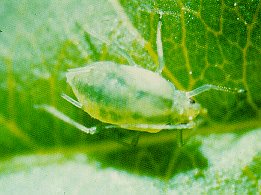
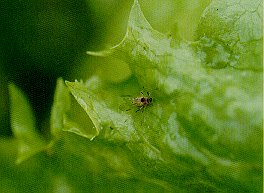
Most aphids have a similar complicated life cycle in Ontario. The green peach aphid overwinters as an egg on peach, plum, wild cherry and other stone fruits. These eggs hatch into female wingless aphids which reproduce by giving birth to live young aphids called nymphs. Nymphs are simply smaller versions of the adults. As these colonies get crowded or the host plant's suitability declines, winged adults are produced which begin dispersing to other host plants like lettuce and celery. Spring populations can also come from sources other than the overwintering hosts. Migrations of winged aphids often arrive in Ontario from southerly areas on weather fronts.
As these aphids reproduce through 10–15 generations, their piercing, sucking mouthparts are used to feed on plant sap. In some cases this feeding transmits viruses from weeds and other plants to lettuce and celery. Populations can build rapidly since females give birth to large numbers of live young without mating. Winged adults are produced as colonies get crowded. In the fall, as the days get shorter, the first males are produced. This final generation disperses back to overwintering hosts, mates and the females lay overwintering eggs.
The sunflower aphid normally appears in celery later in the growing season. The biology of this species in Ontario is not clear. However, in Michigan the sunflower aphid is thought to overwinter on red-osier dogwood and colonize annual sunflowers and other wild sunflower or umbelliferous plants.
The adults and nymphs are darker green than green peach aphids and often appear dark brown or black on celery plants (Figure 2).
Monitoring and management
Dispersal flights of winged aphids can be monitored by using yellow sticky boards placed along field borders. Population levels in the crop are best monitored by visual inspection of the plants. Examine at least 50–100 lettuce or celery plants, checking undersides of leaves and tender new growth. When looking for aphids, treat all aphid species the same and record how many plants are infested with one or more aphids. Calculate the percentage of plants infested.
For example, if you examined 75 plants and found 6 with 1 or more aphids you would have: (6 ÷ 75) x 100 = 8% Field Infestation. Treatments for aphids on lettuce and celery are normally recommended when 3% or more infestation is reached, however other factors greatly influence this decision. The growth stage of the crop, the weed hosts adjacent to the field and the presence of beneficial insects can influence a treatment decision. For example, for celery 2 weeks before harvest, the threshold drops to 1% infestation; for lettuce 1 week before harvest, the threshold drops to 1% infestation.
Many beneficials can significantly reduce aphid infestations. Ladybird beetle larvae (Figure 3), lacewing larvae (Figure 4), cecidomyid fly larvae, syrphid fly larvae (Figure 5) and parasitic wasps are common in lettuce and celery fields and can reduce aphid populations below damaging levels. Parasitized aphids can be recognized by their brown mummified remains which can be seen in lettuce and celery throughout the season.
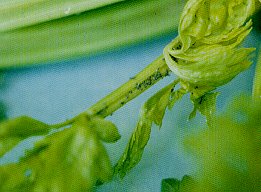
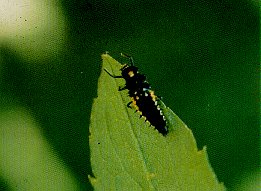
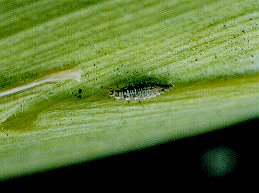
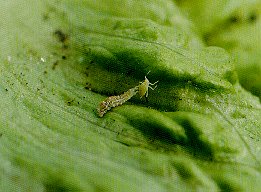
Repeated use of insecticides can lead to resurgent aphid populations because the predators and parasites have been removed. Whenever possible, use products which are selective for aphids.
Weed control in and around fields may reduce aphid populations. Roguing out volunteer plants and plants infected with virus diseases is recommended. Virus-infected plants act as disease reservoirs in the field. Seed-borne and aphid-transmitted lettuce viruses include lettuce mosaic, cucumber mosaic, turnip mosaic and broadbean wilt viruses. In lettuce, virus symptoms include stunting, leaf curling, yellowing and veinal necrosis
Celery viruses include celery mosaic and cucumber mosaic viruses. The symptoms are similar to lettuce viruses, however cucumber mosaic produces characteristic sunken lesions on celery petioles (Figure 6).
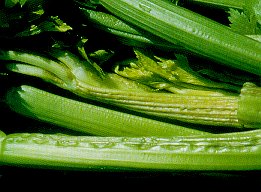
Plant seed that is certified to be free of such viruses. Commercial growers should consult the latest edition of OMAFRA Publication 363, Vegetable Production Recommendations, and the publication Integrated Pest Management for Onions, Carrots, Celery and Lettuce in Ontario, Order No. 700; home gardeners should consult the latest edition of OMAFRA Publication 64, Insect and Disease Control in the Home Garden or contact their local Horticultural Crop Advisor.